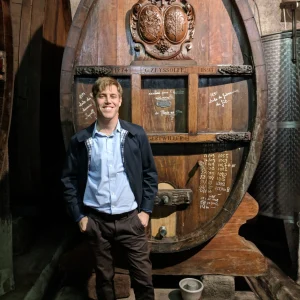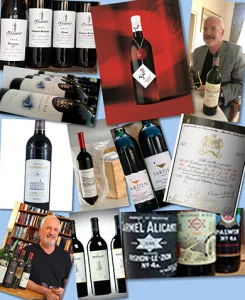I learnt this week that Adv. Gabriel Ginio had passed away in Jerusalem at the grand old age of 97. He was the 6th generation of the Ginio family. Why did this strike a chord within me? This was because it was the Ginio family, who founded the first recorded winery, in the Old City of Jerusalem in 1840. Gabriel Ginio may have been a lawyer, not a winemaker, but to those that met him, he was able to reminisce about the family wine business. May his memory be a blessing.
Most people assume that the Shor family winery was the first winery. This would be incorrect. The Ginio Winery was the first. Shor Winery may be better described as the ‘oldest existing winery’ or the oldest of the current wineries. For the record, the Ginio Winery was founded by David Ginio in 1840. The Shor Winery was founded in 1848 by Rabbi Yitzhak Shor and the Teperberg Winery was founded by Avraham Teperberg in 1870.
The Ginio and Teperberg Wineries were situated in the Jewish Quarter of the Old City of Jerusalem, whilst the Shor Winery was in the Muslim Quarter of the Old City. The Ginios were a Sephardi family, descended from Jews expelled from Spain. From there they settled in Salonica (Thessaloniki in Greece) and came to Jerusalem at the beginning of the 19th century. The Shors and Teperbergs were both Ashkenazi families from the Ukraine, though the Teperbergs arrived via Austria. Hence the Germanic sounding name.
The first Jewish vineyard was only planted by the British Consul James Finn at Kerem Avraham in 1855. However Jewish vine growing would not begin in earnest until the First Aliyah. Three experimental vineyards were planted at Rishon Le Zion and Zichron Ya’acov in 1882, but planting vineyards only took off from 1884, when the efforts were sponsored by Baron Edmond de Rothschild. So the Ginio and Shor Wineries sourced grapes from Arab owned vineyards in the Hebron region. The Shor family had a long term business arrangement with the same grower over decades. Some others took table grapes from the market in the Old City. As almost all of the wine was sweet or sweetened, they would not have been judged by the same quality parameters as today.
Think of Jerusalem of the 1840s. It was dirty, rampant with disease and overcrowded with distressing poverty. Sir Moses Montefiore was the most important visitor to Jerusalem at this time. In all he visited the Holy Land seven times between 1827 and 1875. In 1839 he urged Jews to work instead of living off charity and to return to agriculture, including planting vines and olive trees. He commissioned a census of the Jewish community in both 1839 and 1849. This and his diaries give a good picture of Jerusalem when the Ginio and Shor Wineries were founded.
He established the first neighborhood outside the Old City Walls, Mishkenot Sha’ananim, to ease overcrowding. This became the cornerstone of modern Jerusalem. He also bought the first land to encourage agriculture and built the iconic Windmill to encourage work. As a wine lover (he drank a bottle of wine every day), he would have been satisfied by the Ginio and Shor families initiative to open wineries. Montefiore was able to sample some of the wines made from Hebron grapes and even bought some as a souvenir. However it was not until the 1880s that Rothschild made his vision come true.
I visited the building where the Ginio Winery was situated. It is at the beginning of Yehudim Street in the Old City. There is a plaque outside commemorating the Ginio Winery. The family lived in the house and the basement was the winery. Today it is a second hand bookshop. When I was there I was welcomed by an elegant, refined old lady, who was nearly blind. She showed me the secret entrance behind a movable bookcase and pointed out the trap door where grapes were lowered to the winery. This was a similar set up to the Shor family, who also lived above the winery.
However, the most famous product of the Ginio Winery was Arak. This is the Levant anise flavored spirit, similar to Turkish Raki, Lebanese Arak and Greek & Cypriot Ouzo. Perhaps that explains why the plaque does not feature a wine label, but an Arak label! Apparently the Ginio Arak was very popular in the coffee bars of the Old City…even in Muslim areas! The Ginio emblem was a deer along with the word Ginio and Jerusalem written in Hebrew. Today this custom has been carried on by the Elite and Alouf Arak, produced by the Joseph Gold & Sons, who have been distillers since 1824. Their Araks have two deers on their labels. Elite Arak is the market leader, and has been for as long as I can remember. Who copied who, I have no idea, but both were extremely popular in their time!
The Ginio family were also in the wine trade owning a few wine shops, initially inside the Old City, but later in Western Jerusalem too. The most well-known wine shop and liquor store was in the plaza, just inside the Jaffa Gate, below the Amdosky Central Hotel. The deer logo was visible, inlaid into the paving at the entrance, until it was criminally destroyed by careless renovations in the early 1990’s. The Ginio family sold wines, spirits, liqueurs and imported beer in their shops…and not only their own products. For instance the Shor wines were initially sold there. Of course, we should not forget the legendary Rosa Shor, who opened her famous shop cum wine bar in the cotton market of the Muslim Quarter, of all places.
Only last week another nonagenarian passed away. This was Tsippora Mendelsohn, née Shor. She was a matriarch of the Shor winemaking dynasty and she later owned Shimshon Winery with her husband, Yona Mendelsohn. Different branches of the Shor family today own and manage 1848 Winery, Arza Winery, Hacormim Winery, Hayotzer Winery, Shorr (sic) Estate and Zion Winery. That is quite something. They are still in the wine business after 174 years and still counting. It should not be taken for granted.
Most wineries do not stand the test of time, especially under the same ownership. They are usually either sold or cease to exist altogether. For example, Shimshon Winery, also founded by the Shor family, was passed on to the Mendelsohns, who sold it in 2006. It still exists and is now known as the Jerusalem Vineyard Winery. The Ginio Winery though, continued to operate until the Jewish Quarter fell in 1948 and then faded away. Many wineries fall by the wayside either because of trading problems and or more likely, the next generation is just not interested in wine and want to do something different.
Now all that remains are these plaques described here, folklore and memories of those old enough to remember. Many assume that the Ottoman Empire did not permit wine production because of the Muslim prohibition against alcohol. However, the Ginio, Shor and Teperberg Wineries show wine was produced. Their businesses were small, boutique, even domestic in our terms, based on family and community first and foremost. Yet these three names are proof there was wine in the Holy Land before Carmel was established.
Adam Montefiore is a wine industry insider turned wine writer, who has advanced Israeli wines for 35 years. He is referred to as the English voice of Israeli wine. He is the wine writer for the Jerusalem Post. www.adammontefiore.com


















